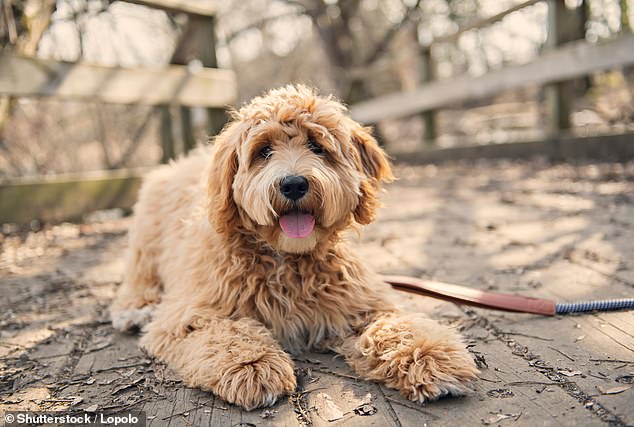Thinking about getting a dog? Scientists reveal the breeds that grow the MOST from puppies to adults – with once pooch increasing in size by 900%
- Sixty of the UK’s most popular dog breeds were assessed in a Petplan study
- Labradoodles pick up the most weight from their puppy phase to adulthood
- Mini Cavapoo weight only jumps up by 50 per cent from eight weeks to a year
Welcoming a puppy into the family home is often a dream of many.
But experts are urging owners to be aware of what’s in store, as certain dog breeds can hugely increase in size as they reach adulthood.
Sixty of the UK’s most popular and common dog breeds were measured at eight weeks old and again one-year-old as part research by Petplan.
Labradoodles topped the charts for picking up most weight, with a 900 per cent jump in size from its puppy phase to adulthood.
Labrador Retrievers and Rottweilers followed just behind, as their bodies changed by 700 per cent and 692 per cent over the same time period.

Sixty of the UK’s most popular and common dog breeds were assessed in a Petplan study

A Labradoodle’s weight can increase by 900 per cent from the puppy phase to adulthood
The study comes at a time when pet homes across the UK are brimming with abandoned dogs and cats.
Rehoming centres believe the cost-of-living crisis has worsened this, with cash-strapped Brits handing over their pooches in numbers unseen since the 2008 crash.
As a result, Petplan believes it is vital that people are aware of how much money, effort and space is needed to keep certain breeds.
Kennel Club Dog Trainer, Joe Nutkins, also added that larger dogs may cost 50 per cent more than smaller breeds when it comes to leads, collars and other essentials.
He told MailOnline: ‘When choosing your breed type of puppy or young dog it’s important to remember they will grow to have varying needs.
‘A smaller dog will have the smaller costs as there’s less materials for collars, beds or coats, less meds needed per dose and less daily food intake for meals and treats. A bigger size dog could have 50 per cent upwards added to the costs of the same items so it’s worth beating this is in mind when choosing your next puppy or adult dog!’
While Labradoodles and similar dogs may be a lot to handle, there are other breeds that do not grow so much as they age.
The weight of Mini Cavapoos – a Mini Poodle and Cavalier King Charles Spaniel cross – only jumps up by 50 per cent from eight weeks to a year.

A Mini Cavapoo’s weight only jumps up by 50 per cent from eight weeks to a year
Meanwhile, a Chihuahua’s weight will increase by just 100 per cent, while a Staffordshire Bull Terrier’s will rise by 118 per cent.
Even so, Mr Nutkins stressed that prospective pet owners need to understand that cost and exercise needs are impacted by other factors too.
He continued: ‘Levels of fitness differ with each dog, based on a dog’s breed type rather than just size. A a Jack Russell Terrier is likely to be more active for longer periods then a Greyhound or Mastiff breed.
‘Although we can walk our dogs and play game at home for free, it’s still wise to consider what additional costs may be included if you needed a dog walker, took part in dog training and activities or wanted to hire a secure field.’

The weight of Mini Cavapoos – a Mini Poodle and Cavalier King Charles Spaniel cross – only jumps up by 50 per cent from eight weeks to a year
Petplan’s research took into account data from The Kennel Club and HelloBark, in addition to professional sources of the pet insurance company.
Female dogs were excluded in this study, with a sole focus on male puppies and grown adults.
Height change was another factor looked at by experts, which can play a part in costs for bedding and other equipment.
English Springer Spaniels were seen to grow more than three times their puppy size in height, with Golden Retrievers a runner up at 267 per cent.
On the flipside, Border collies only saw an increase of 13 per cent, followed by Pugs at 25 per cent and Poodles at 50 per cent.
‘If you are considering bringing a dog into your family do spend time researching the breed types you are interested in to have an idea of how big a puppy may grow or the size of a rescue dog,’ Mr Nutkins added.












